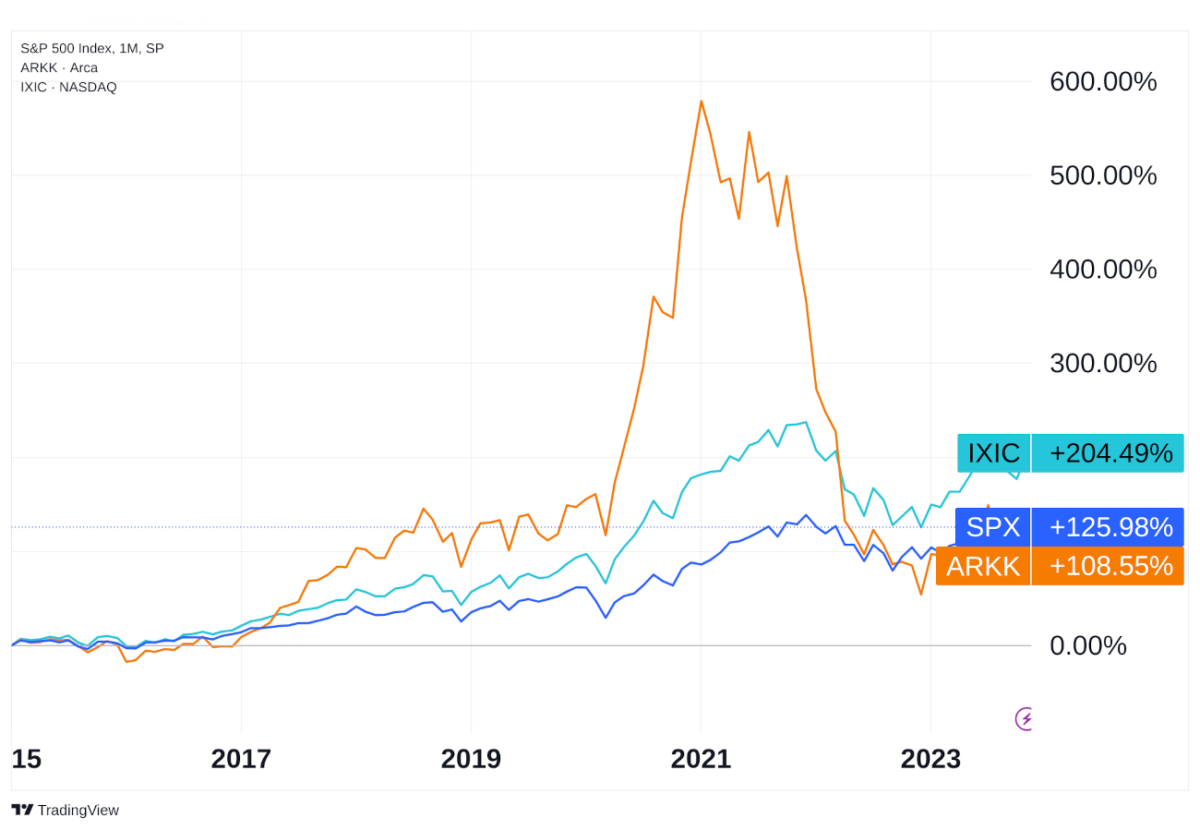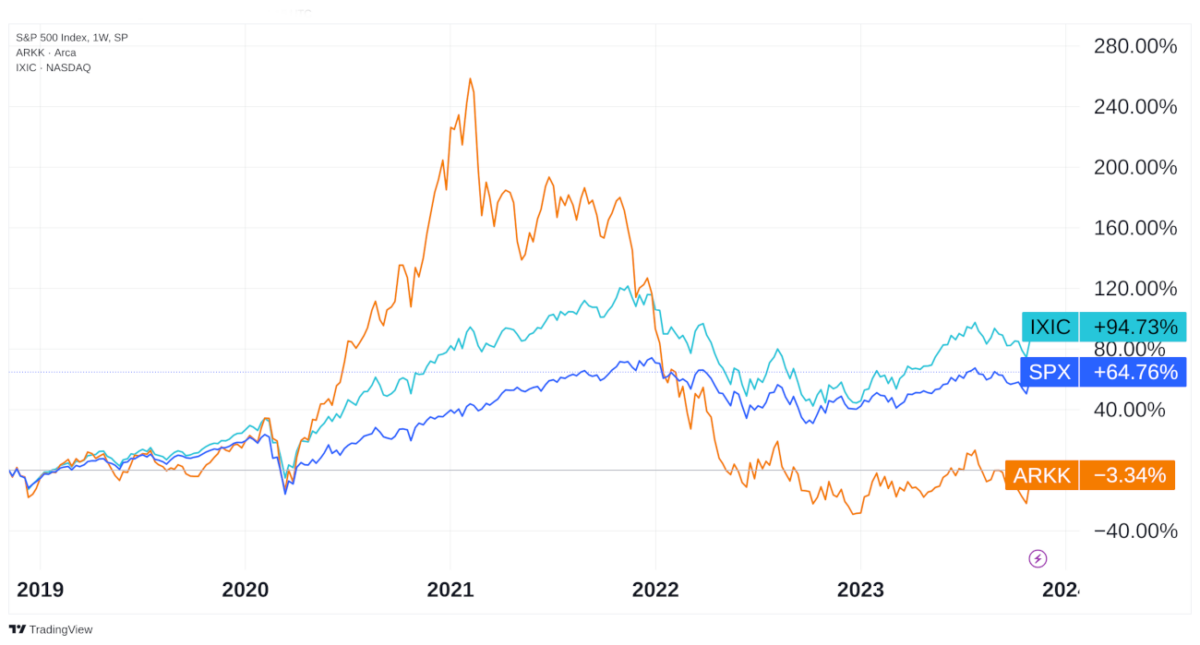Do Not Follow the Leader

One of the biggest benefits of ETFs is that they allow individual investors to hold diversified portfolios, rather than concentrating their holdings. However, there is a proliferation of stock pickers making bold and concentrated bets. Some of these bets have been transferred to the ETF world. Does it pay to follow the bold bets of others? Are these bets worth making?
Cramer Inverse ETF (SJIM)
There is a lot to be said about Jim Cramer and the funds that try to track the performance of his stock picks. With more than 40 years of experience and as a TV personality, Cramer has both supporters and detractors. This has given rise to two ETFs launched by Tutle Capital Management. The first – the Long Cramer ETF (LJIM) – attempts to track Cramer’s picks, while the second – the Inverse Cramer Tracker ETF (CBOE:SJIM) – does exactly the opposite. Due to a mix of a lack of communication between Cramer and the fund’s management and a lack of investor interest, the Long Cramer ETF was liquidated in September, just six months after its launch.
The Inverse Cramer Tracker ETF is an actively managed ETF that attempts to provide investors with the exact opposite of Jim Cramer’s picks by shorting the stocks he recommends. According to the fund’s fact sheet, under normal circumstances, at least 80% of the fund’s investments will be in the inverse of the securities mentioned by Jim Cramer. As of 15 November 2023, the fund had 56 holdings and $3.2 million in assets. It currently has a performance of -7.9% over the last six months. Some of the short positions include AirBnB, Amazon, Apple, Meta Platforms and Microsoft. On the long side, some of the stocks are Alcoa, United States Oil and Moderna.
I would say that these funds should not be taken too seriously, as there is no particular reason to build a portfolio that either tracks or goes against Cramer’s picks. However, these funds do try to prove an important point about stock pickers, which is the perceived lack of accountability that stock pickers take for bad bets. Most of the time they don’t beat the market, and they take on a lot more risk than the market as a whole. In many cases, buying the market portfolio with leverage is simply much better than trying to boost performance by taking on diversifiable idiosyncratic risk.
Roundhill MEME ETF (MEME)
Next on my list is the Roundhill Meme ETF (NYSEARCA:MEME). This fund invests in meme stocks, which are stocks that attract the attention of retail investors on social media and have high levels of short interest. Over the past few years, there has been a growing interest in stocks based on social media commentary. Many retail investors end up buying these stocks based on hype, while some people may just use social media to try to manipulate the price of these stocks. Cryptocurrencies, for example, have been heavily exposed to social media manipulation, resulting in increased volatility.
When these stocks fall out of favour on social media, their price falls sharply because most of these stocks have little intrinsic value. The key point about meme stocks is that they are a poor long-term strategy. These strategies expose investors to price manipulation. Unlike value stocks, which can underperform in some periods but still have fundamental value, most meme stocks trade at very high multiples, exposing investors to large losses. Over the past year, Meme is down 1.8% while the S&P 500 is up 14%. Even if the fund were to outperform the S&P 500 in terms of return, its high volatility would make it a poor risk-adjusted performer.
Ark Innovation ETF (ARKK)
The** ARK Innovation ETF (NYSEARCA:ARKK)** is an actively managed exchange traded fund that seeks to capture the performance of what the fund calls disruptive innovation. The fund’s manager, Cathie Wood, aims to invest in companies that will ultimately shape our future by providing new products and services that have the potential to change the way the world works. Her holdings include companies that are expected to benefit from the development of new products, technological improvements and advances in scientific research. Most of these companies are related to areas such as artificial intelligence, robotics, energy storage, DNA sequencing and blockchain technology. According to recent filings, ARK’s top holdings include CoinBase Global, Roku, Tesla, Zoom and UIPath.

The fund’s performance has been very volatile over the years. It returned 3.5% in 2018, 153% in 2019 and a staggering 153% in 2020. However, it lost 23.4% in 2021 and 67% or two-thirds of its value in 2022. Taking 2022 alone would be a reason to stay away from this fund. Over the last five years, ARK is down 3.3%, while the S&P 500 is up 64.8% and the Nasdaq Comp is up 94.7%. Given ARK’s very high concentration, its high idiosyncratic risk and its volatility over the years, I would say that ARK looks like a very poor investment on a risk-adjusted basis. Unfortunately, investors get seduced by the advertised performance during periods when the broader market is rising, when this type of fund rises much more.
The ARK ETF has come under fire over the years for its poor performance, high risk and bold investment strategy. While investing in potentially disruptive technologies carries specific risks that are higher than for the broader market, ARK’s concentration has proven disastrous when the broader market declines, with the ETF losing a significant portion of its value when the recent bubble burst. The fund concentrates two-thirds of its assets in just 10 holdings, and only a quarter of its holdings are profitable through the end of 2022. In my view, this fund exposes investors to a bold, unbalanced and leveraged bet that is unlikely to deliver alpha. Investors may be better off simply making a leveraged bet on the Nasdaq 100 by investing, for example, in the Invesco QQQ Trust(NASDAQ:QQQ), which has an expense ratio of 0.20% instead of ARK’s 0.75%, while being more balanced and diversified.

Final words
ETFs should be praised for giving individual investors the opportunity to build a low-cost, well-diversified portfolio. For example, it is possible to build a traditional stock/bond portfolio using just two ETFs. This allows investors to avoid concentrating their money in just a few holdings. So why make bold bets? Why take unnecessary risk when you can eliminate it? While Cathie Wood and Jim Cramer have their own merits, the former’s bold bets and the latter’s lack of accountability for bad bets are good examples of what investors can avoid when using ETFs to build their portfolios.
Comments (0)